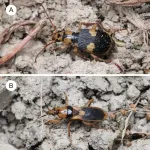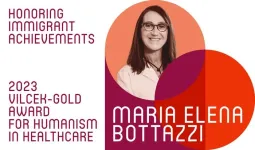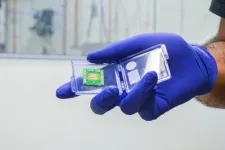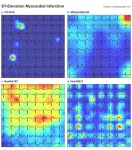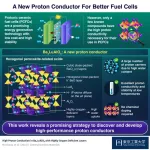(Press-News.org) COLUMBUS, Ohio – Therapeutic nanocarriers engineered from adult skin cells can curb inflammation and tissue injury in damaged mouse lungs, new research shows, hinting at the promise of a treatment for lungs severely injured by infection or trauma.
Researchers conducted experiments in cell cultures and mice to demonstrate the therapeutic potential of these nanoparticles, which are extracellular vesicles similar to the ones circulating in humans’ bloodstream and biological fluids that carry messages between cells.
The hope is that a drop of solution containing these nanocarriers, delivered to the lungs via the nose, could treat acute respiratory distress syndrome (ARDS), one of the most frequent causes of respiratory failure that leads to putting patients on a ventilator. In ARDS, inflammation spiraling out of control in the lungs so seriously burdens the immune system that immune cells are unable to tend to the initial cause of the damage.
“These extracellular vesicles would be an alternative ARDS therapy that gives a fighting chance to your own immune system,” said senior author Natalia Higuita-Castro, associate professor of biomedical engineering and neurosurgery at The Ohio State University. “The issue with ARDS is that you have a shift in the normal balance that favors inflammation. By introducing the anti-inflammatory agents, you shift that balance to a more level stage so the immune system can resolve the underlying issue.”
The study was published online recently in the journal Advanced Materials.
Starting the engineering process with adult skin cells called dermal fibroblasts is a significant secret to this technology’s success, noted Higuita-Castro, also director of advanced therapeutics and engineering in the College of Medicine Davis Heart and Lung Research Institute.
Many nanocarriers are engineered from stem or progenitor cells that can differentiate into other cell types, but also have mysterious properties that aren’t yet fully understood.
“Using skin cells from adult animals is very important for us because we wanted to demonstrate the feasibility of translating this to clinical settings, where we could have a universal donor cell from adult patients,” Higuita-Castro said. “Dermal fibroblasts are easily available, we can grow them, they’re used in the clinic for grafting and wound healing, and they don’t produce an immune response like that seen with other cell sources.”
To create the vesicles, scientists apply an electrical charge to a donor skin cell to transiently open holes in its membrane, and deliver externally obtained DNA inside. The donor cell converts that genetic information into one of two anti-inflammatory proteins as well as into messenger RNA, molecules that translate instructions for the manufacture of more of those functional proteins.
Those materials are the payload inside these nanocarriers, whose surfaces are tagged with a molecule enabling interaction with specific cells to improve their retention in the lungs. In this study, separate nanocarriers were packed with one of two anti-inflammatory proteins, IL-4 or IL-10, plus mRNA for recipient cells in the lung to process and make more protein.
“The proteins have an immediate effect, and adding mRNA will give a more sustained effect,” said Higuita-Castro, also a core faculty member of Ohio State’s Gene Therapy Institute.
The different proteins were not combined into one vesicle for a reason: “Our vision for clinical applications is to have a mix-and-match platform depending on what the patient needs,” she said. “That way, we could also administer lower doses multiple times, if needed, and re-dosing with these nanocarriers will be OK because they don’t trigger a significant immune response.”
Cell culture experiments suggested these vesicles could be used as a pre-treatment in sick patients at high risk for developing ARDS. Studies in mice showed their potential to help patients who are already severely ill.
After mice were injected with a molecule that triggered high inflammation in the lung, researchers gave them a single drop of liquid loaded with engineered nanocarriers that traveled straight to their injured lungs and got to work. Inflammation was reduced as expected, but repeated experiments in the animals showed the vesicles also lowered damage to lung tissue.
Even more exciting to Higuita-Castro was a finding that cells in the treated lungs secreted substances with additional therapeutic benefits – including antioxidants and more anti-inflammatory molecules.
“Honestly, that was mind-blowing,” she said. “It’s a local treatment because it’s delivered intranasally, and it stays in the lung because we designed it that way, but it has this global effect that is really powerful.”
Finding a safe, effective treatment for ARDS is a significant medical need. The current use of ventilators and steroids comes with lots of side effects, and while the dangerous lung condition used to be relatively rare, case numbers skyrocketed during the COVID-19 pandemic.
“COVID-19 shined a light on the lack of effective therapeutic options for acute lung injury in general,” Higuita-Castro said.
There is more to do with the nanocarriers, including pinning down the precise details of all they can do to repair damaged lungs and testing the therapy in larger animals. But Higuita-Castro is optimistic about the technology’s future.
“These extracellular vesicles are naturally derived nanoparticles, and we think they’re great because nature is the best example we could have – as it has had millions of years to optimize the system,” she said.
This research was funded by Ohio State Office of Research COVID-19 seed funding and grants from the National Institutes of Health.
The work was led by co-first authors Ana Salazar-Puerta and María Rincon-Benavides. Additional Ohio State co-authors included Tatiana Cuellar-Gaviria, Julian Aldana, Lilibeth Ortega-Pineda, Devleena Das, Daniel Dodd, Charles Spencer, Binbin Deng, David McComb, Joshua Englert, Samir Ghadiali, Loren Wold and Daniel Gallego-Perez. Gabriela Vasquez Martinez and Diana Zepeda-Orozco of Nationwide Children’s Hospital also worked on the study.
#
Contact: Natalia Higuita-Castro, Higuitacastro.1@osu.edu
Written by Emily Caldwell, Caldwell.151@osu.edu; 614-292-8152
END
Animals can defend themselves against their natural enemies in various ways. Well-defended species often share conspicuous body colors with other well-defended or undefended species, forming mimetic interactions. Bombardier beetles eject toxic chemicals at a temperature of 100°C to repel enemies such as frogs, and many have warning body colors that function to deter enemies. An assassin bug, Sirthenea flavipes, exhibits a conspicuous body color similar to the bombardier beetle Pheropsophus occipitalis jessoensis which coexist with the assassin bug in the same habitat in Japan (Fig. 1). The assassin bug can stab with its proboscis, ...
New York, NY, June 6, 2023 — The Vilcek Foundation and The Arnold P. Gold Foundation have announced they will bestow the 2023 Vilcek-Gold Award for Humanism in Healthcare on Dr. Maria Elena Bottazzi at the Association of American Medical Colleges (AAMC) meeting in Seattle on November 4, 2023.
The Vilcek-Gold Award is a shared initiative of the Vilcek Foundation and the Gold Foundation that embodies the missions of both organizations. The award recognizes an outstanding immigrant healthcare professional ...
A University of Minnesota Twin Cities-led team has developed a new superconducting diode, a key component in electronic devices, that could help scale up quantum computers for industry use and improve the performance of artificial intelligence systems. Compared to other superconducting diodes, the researchers’ device is more energy efficient; can process multiple electrical signals at a time; and contains a series of gates to control the flow of energy, a feature that has never before been integrated into a superconducting diode.
The paper is published in Nature Communications, a peer-reviewed scientific journal ...
A doctoral thesis has demonstrated that motor skills and physical activity practice can support the cognitive and early academic skills of preschoolers, particularly when the activities include motor skills practice, or when motor skills or physical activity practice is combined with the subject to be learnt.
In recent years, concerns have been raised about children and adolescents being less physically active and having weaker motor skills than previous generations. A further cause of concern is the decline of for instance mathematical and language skills, with an increasing number of children ...
New York, NY (June 6, 2023) – Mount Sinai researchers have developed an innovative artificial intelligence (AI) model for electrocardiogram (ECG) analysis that allows for the interpretation of ECGs as language. This approach can enhance the accuracy and effectiveness of ECG-related diagnoses, especially for cardiac conditions where limited data is available on which to train.
In a study published in the June 6 online issue of npj Digital Medicine DOI: 10.1038/s41746-023-00840-9, the team reported that its new deep learning model, known as HeartBEiT, forms a foundation upon which specialized diagnostic models can be created. The team noted that in comparison ...
The discovery of Ba2LuAlO5 as a promising proton conductor paints a bright future for protonic ceramic fuel cells, report scientists from Tokyo Tech. Experiments show that this novel material has a remarkably high proton conductivity even without any additional chemical modifications, and molecular dynamics simulations reveal the underlying reasons. These new insights may pave the way to safer and more efficient energy technologies.
When talking about sustainability, the ways in which a society ...
Scientists from the UCLA Jonsson Comprehensive Cancer Center have developed a new method to bioprint miniature tumor organoids that are designed to mimic the function and architecture of real tumors. The improved process allows researchers to use an advanced imaging method to study and analyze individual organoids in great detail, which can help researchers identify personalized treatments for people with rare or hard-to-treat cancers.
The method is described in the journal Nature Communications.
“Tumor organoids have become fundamental tools to ...
The addition of ‘trust’ and ‘distrust’ buttons on social media, alongside standard ‘like’ buttons, could help to reduce the spread of misinformation, finds a new experimental study led by UCL researchers.
Incentivising accuracy cut in half the reach of false posts, according to the findings published in eLife.
Co-lead author, Professor Tali Sharot (UCL Psychology & Language Sciences, Max Planck UCL Centre for Computational Psychiatry and Ageing Research, and Massachusetts Institute of Technology) said: “Over the past few years, the spread of misinformation, or ‘fake news’, has skyrocketed, ...
One of the challenges in treating burn victims is the frequency of dressing changes, which can be extremely painful.
To bring relief to this and other problems, University of Waterloo researchers have created a new type of wound dressing material using advanced polymers. This new dressing could enhance the healing process for burn patients and have potential applications for drug delivery in cancer treatment as well as in the cosmetic industry.
"To treat burn victims, we can customize the shape using a 3D printer, secondly, the material has fine-tuned surface adhesion, which is a key feature", said Dr. Boxin Zhao, a professor in Waterloo's Department of ...
Chatbots are increasingly becoming a part of health care around the world, but do they encourage bias? That’s what University of Colorado School of Medicine researchers are asking as they dig into patients’ experiences with the artificial intelligence (AI) programs that simulate conversation.
“Sometimes overlooked is what a chatbot looks like – its avatar,” the researchers write in a new paper published in Annals of Internal Medicine. “Current chatbot ...
